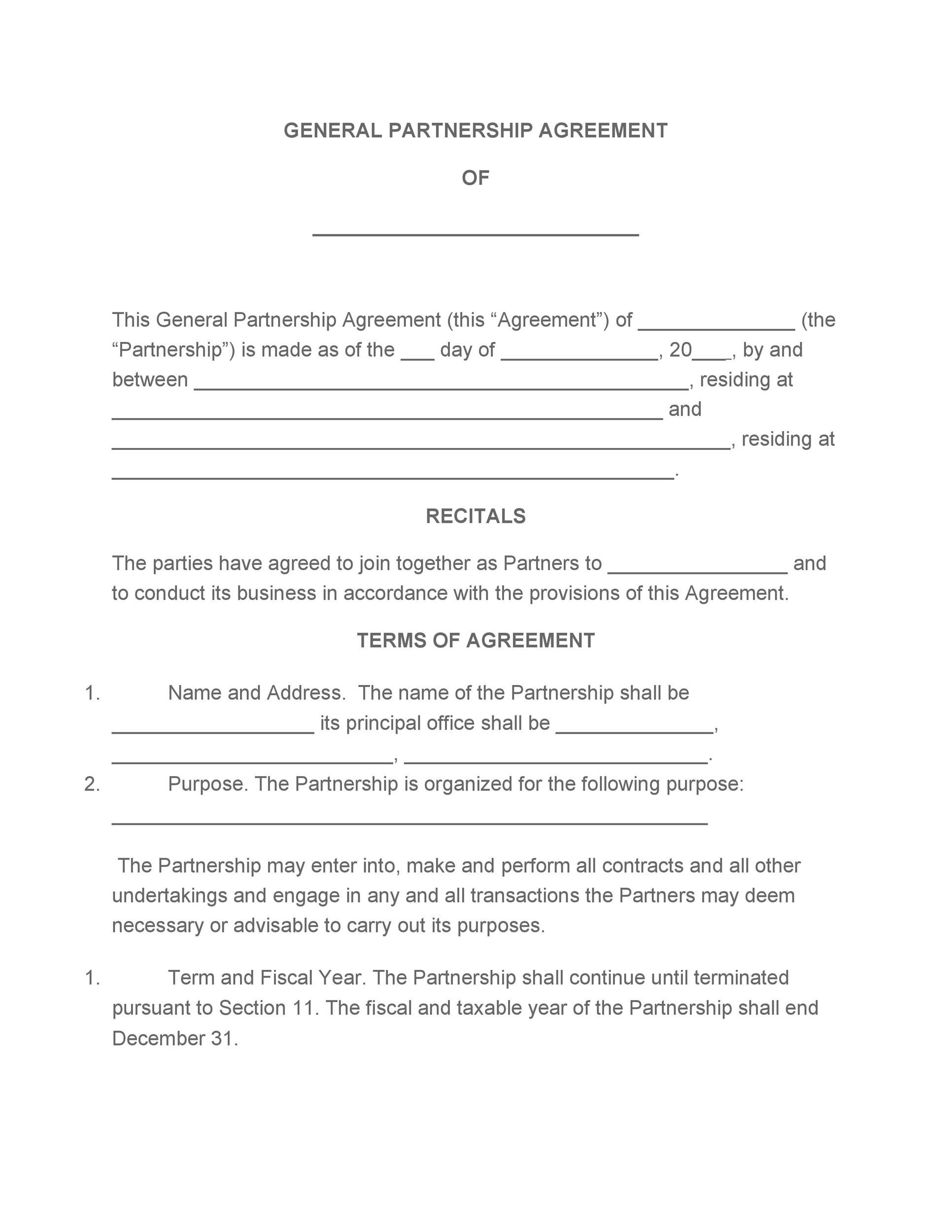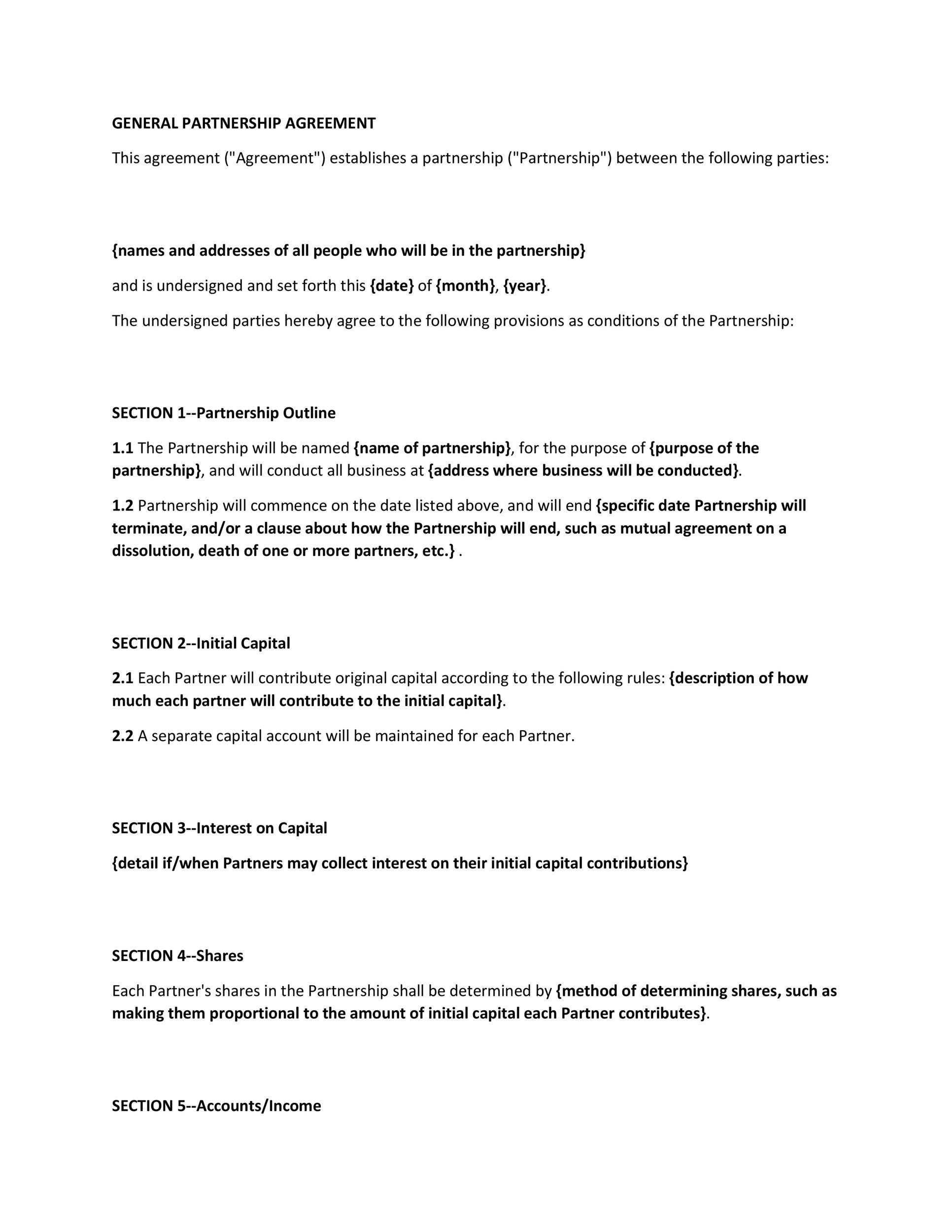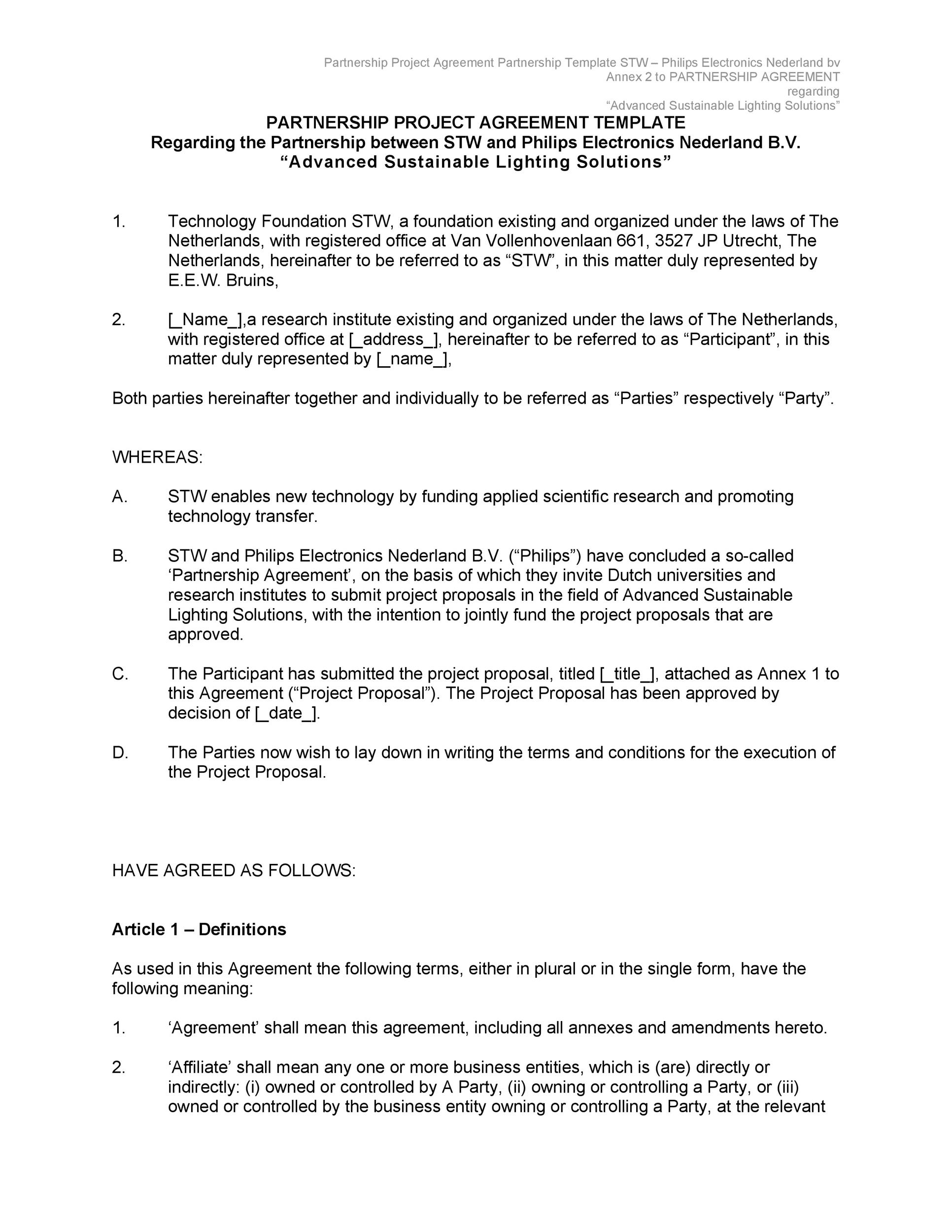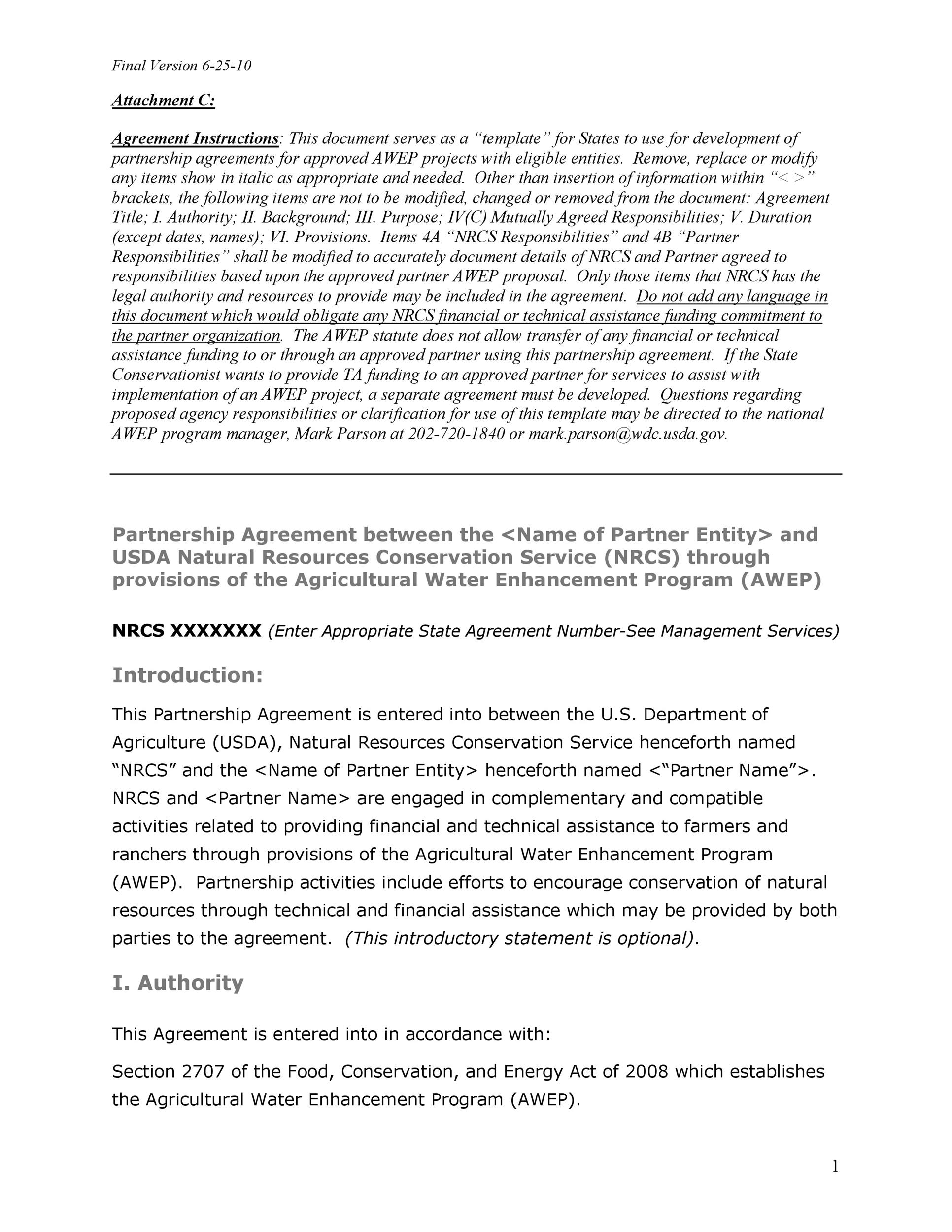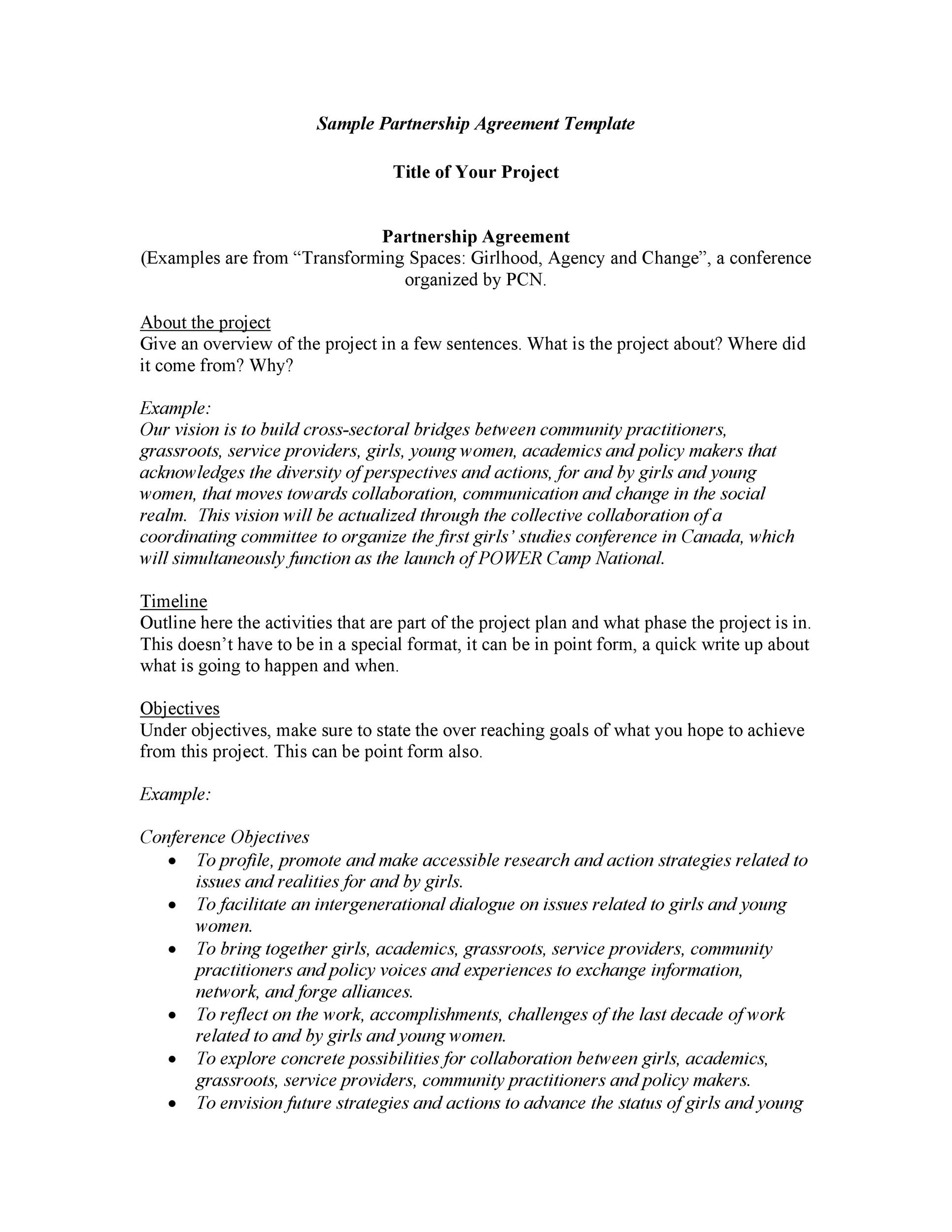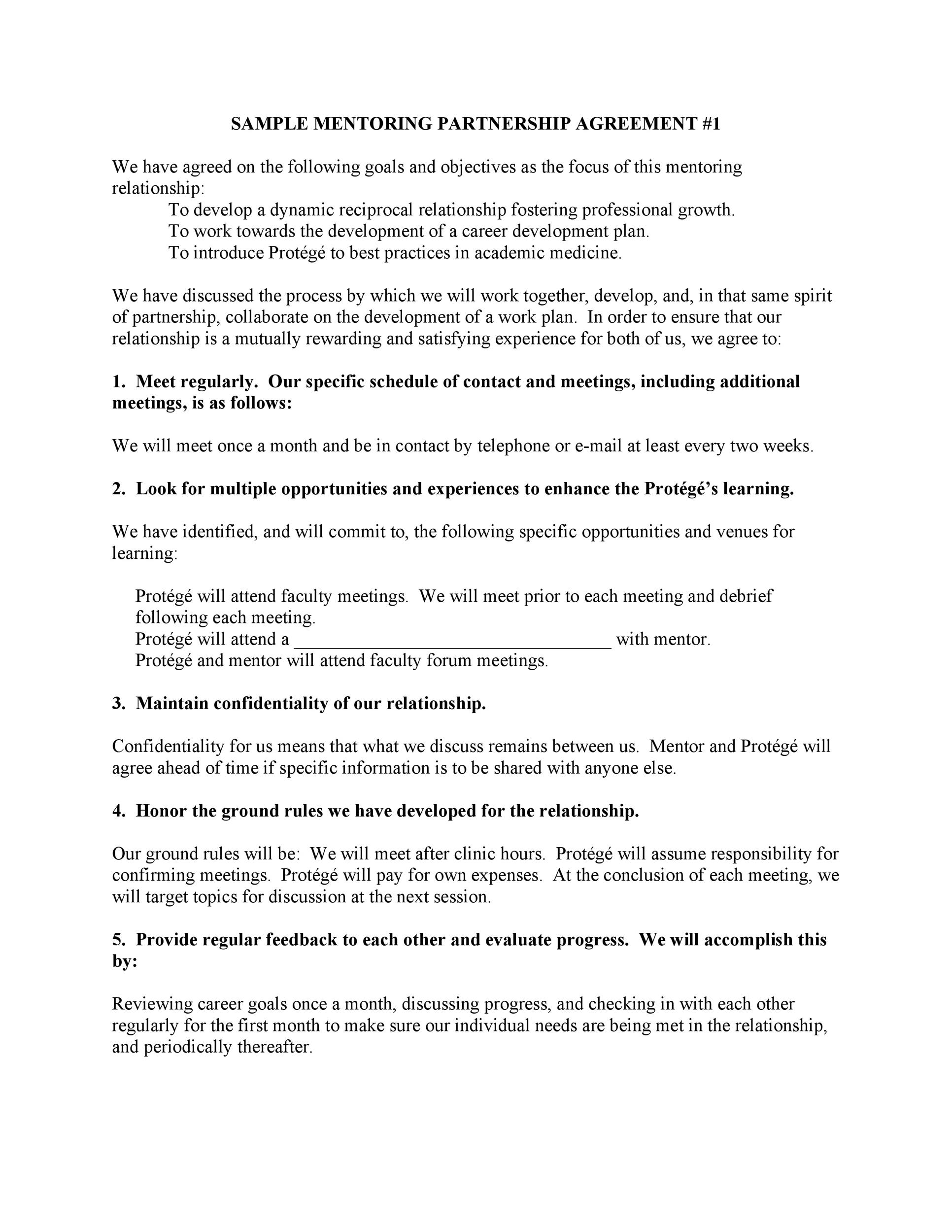When you are working on drafting a partnership agreement template, you might be tempted to look at business partnership agreement template examples and copy off them. The trouble with using just any partner agreement form for this task is that the business partnership agreement template that you write needs to be specific to your unique situation. Each business model and agreement style will have unique requirements that must be carefully explained for the partnership agreement to be binding and valid. You will want to be certain that you are familiar with all the necessary parts of your partnership agreement before you write one that does not cover your needs correctly. The partnership documents that you and your partner have access to explain the relationship between you and help to protect you both from legal action if there are conflicts in the future.
Table of Contents
- 1 Partnership Agreement Templates
- 2 What Should be Included in the Partnership Agreement?
- 3 Partnership Agreement Examples
- 4 How Do You Prepare a Partnership Agreement?
- 5 Partnership Agreement Samples
- 6 What Are The Types of Partnership?
- 7 Is a Partnership Agreement Legally Binding?
- 8 Business Partnership Agreements
- 9 Some Other Considerations
- 10 Partnership Agreements Need to be Detailed and Accurate
Partnership Agreement Templates
What Should be Included in the Partnership Agreement?
There are some basic details that must be in every business partnership agreement. You will need to be very clear about any unique considerations or agreements that exist between you as partners as well. You cannot leave anything to a handshake deal or a verbal discussion when it comes to business contracts. The clearer that you are about the business relationship in question, the more likely it will be that you and your partners will get along and manage your business without issue.
- Who The Partners Are. This information needs to include names, addresses, and business entity names that might be involved in the contract. Everyone who is a partner must be named and must have looked at this document as well.
- What Each Partner Contributed. This information can be monetary, or it might be assets like buildings, property, machines, inventory, or anything else that needs to be accounted for in the partnership agreement. You will need to carefully outline what each partner has brought to the table. This is important in case a partner wants to sever their ties with your business later through a buyout.
- Where the Business Operates. Be clear about the state as well as the county and the location’s address. The laws that govern businesses are state specific but can also be impacted by county considerations. You need to be sure that your contract is taking into consideration state laws as well as local county laws.
- When the Business Was Opened. The date that the business was opened or will be opened needs to be included in the contract. This is the effective date of everyone’s investment becoming legally binding, and this information is critical if there is a need to resolve disputes in the future.
- Why the Business Was Formed. The reason that you have made your business can be unique to your company’s goals, or it might simply be to earn profit. There does not need to be more information included in this part of the contract than what accurately describes the reason that your business was opened.
- How Profits and Losses Are Handled. The profits and losses of your business are the heart of what the business partnership is intended to govern. You will need to be clear about who is getting which profits and who is liable for losses as well. The clearer that you are about this part of the information in the contract, the less likely it will be that you will have disagreements or conflicts with your partners down the road over finances and funding concerns.
- What Happens if a Partner Leaves or Passes Away. There are various ways that you can handle the process of a partner passing away or leaving the company. You might have already decided what the process will be should this even come to pass, but if you have not, all the partners need to talk and agree. You will need a process that is fair and equitable and that protects the business itself from being broken apart due to the loss of a partner. There are various ways that you can offer up the share of the business to the other business partners, and you and your partners can decide which method of handling this situation is the fairest. Make sure to think about spouses that might gain rights to the partnership through a divorce and other considerations related to inheritances as well.
Some other items that will need to be considered in your business agreement are the capital accounts which are often kept separate from personal accounts to protect business interests. You will also need to include information about income accounts which are also managed separately to prevent fraud and other issues with the cash that is flowing into the business.
Detailed information about your salary and how money is drawn for the partners as well. You will not want partners to have the right to draw income at will. Make sure that you like the bank accounts that are used to handle funds as well. These details need to be public, and they need to be available to all the partners for the agreement to be fair and valid.
Partnership Agreement Examples
How Do You Prepare a Partnership Agreement?
The best way to go about preparing this kind of document is to make sure that you and your business partners have a meeting and discuss your goals and plans related to this part of your business formation. You will need everyone to sign the agreement once it has been drafted, and then it becomes legally binding. All the partners need to be able to agree upon all the details of the contract for it to be signed and followed properly as the business is managed.
There are many legal considerations that you might need to keep in mind for this contract writing process, and it can be a good idea to have a legal expert involved in the contract writing process if only to make sure that the final document is complete and accurate. You might need to have various state laws or county laws referenced in the sections to do with passing on the business if someone wants to leave the partnership or if they pass away as well.
Making sure that the legal aspects of the contract have been handled correctly is as important as describing the relationship between the partners and their responsibilities to the business. The more clarity that you offer about these details, the less likely it will be that you and your partners will run into conflicts of interest with regard to an understanding of how the business is to be managed. Make sure as well that you are clear about the kind of partnership that you are drafting a contract for. Selecting the wrong business type can lead to issues down the road when legal incidents come to pass or when there is confusion about the nature of the partners’ relationship to the business.
Partnership Agreement Samples
What Are The Types of Partnership?
There are a few unique types of business partnership agreements that you might need to use for your partnership documentation. These agreements are unique to the kind of business relationship that is being documented, so you need to be certain that you are using the right partnership agreement for your business relationship when you are drafting this document.
- Limited Partnership Agreement. This agreement is for business relationships that include a general partner and a limited partner. The general partner is the person that owns the business and runs it while the limited partner is an investor or someone who is involved only with financing. Both parties are liable for the business, however, and can be held accountable for business losses and other duties toward the business.
- Limited Liability Partnership Agreement. In this business style, each partner has limited personal liability for the debts of the partnership or business. The partners are not liable for tortious damages but might be liable for contractual debts depending on the state that governs the contract’s execution.
- Real Estate Partnerships Agreement. This partnership agreement is for business partners that have the same goals toward creating a joint venture of some kind that involves a real estate purchase. Both parties will be liable in this kind of partnership, but both parties do not have to put up equal cash or stakes in the business.
- 50/50 Partnership. In the 50/50 partnership agreement, both parties agree to share losses and profits equally as they manage and run their business.
- Small Business Partnership. This is the most general of the partnership arrangements and merely indicates the agreed-upon details that the partners have worked out for their specific business agreement. You could use any of the above partnership styles as your basis for this kind of business agreement, but you might also have a more unique way that you have decided to run your business. This document can be made to work with any need so long as there are no investors and other parties that are not going to be protected or identified by the language of this contract.
Is a Partnership Agreement Legally Binding?
Business partnership documents are considered to be legally binding. This is why it is so important to have written your partnership documents correctly. The agreement that you sign to go into business with someone is binding and should be considered a contract that will define the way that you profit from and manage your business going forward.
When business partnership agreements are not correctly drafted, one party might end up with more of the share of the responsibility or cost of the agreement than the other. There can also be confusion about the ownership ratios of the expectations of partners to run or contribute to the business. Making sure that your partnership agreement is correctly written will greatly improve the communication that you and your business partners have about the nature of the contract that you have created.
Business Partnership Agreements
Some Other Considerations
You might also need to include some other clauses in your business agreement between partners. These considerations might need to be added to your final document:
- Restrictions on Transfer. This is a clause that restricts one party from being able to transfer their interests to another party in the partnership. This is important to protect the shares of the business and prevent backdoor deals.
- Arbitration. Information about what will happen if disputes come to pass is important to any legal contract. Make sure that you have a segment in your contract about how legal disagreements will be handled.
- Governing Law. The state that your business operates in will offer up legal precedents and regulations that you must follow to run your business properly. This information will need to be referred to in your contract to make it valid and binding.
Partnership Agreements Need to be Detailed and Accurate
The nature of business relationships must be carefully and completely detailed in your partnership agreement documents. When you are writing these documents, you need to be sure that you cover all of the right legal information as well as outline the nature of the relationship between the parties. The partnership agreement is legally binding and must be followed by all the parties that are involved in the ownership and management of a business.
When you draft a proper partnership agreement, the business in question will be protected from issues related to partners leaving, passing away, or choosing to make changes to the nature of the business. You will want to be sure that you and your partners have agreed to the partnership agreement that will be drafted and that all the right information is included related to the state and location of the business. The more detail that is included in this partnership agreement, the better, and you will have a much easier time managing a partnership with a detailed agreement in place.












